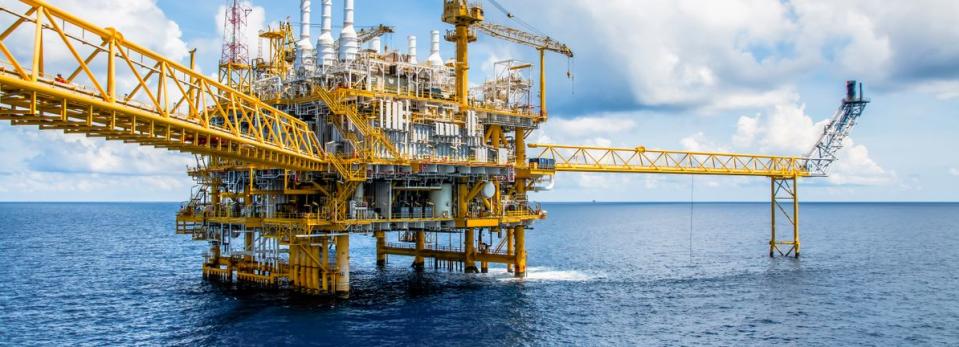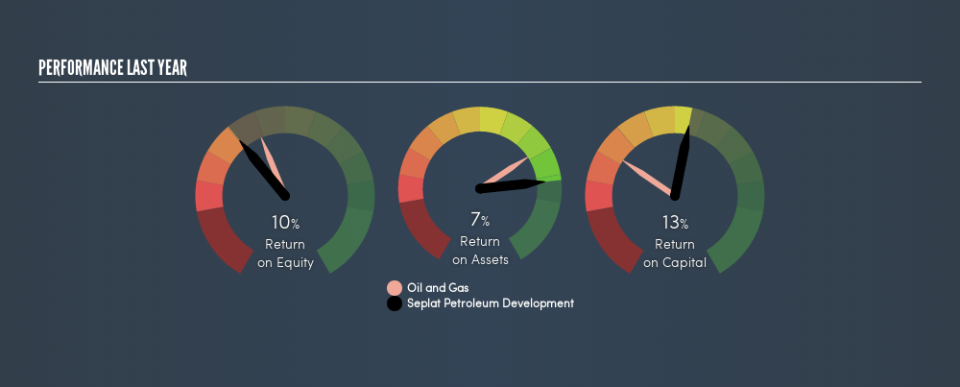What Can We Make Of Seplat Petroleum Development Company Plc’s (LON:SEPL) High Return On Capital?

Want to participate in a short research study? Help shape the future of investing tools and you could win a $250 gift card!
Today we are going to look at Seplat Petroleum Development Company Plc (LON:SEPL) to see whether it might be an attractive investment prospect. Specifically, we're going to calculate its Return On Capital Employed (ROCE), in the hopes of getting some insight into the business.
First up, we'll look at what ROCE is and how we calculate it. Then we'll compare its ROCE to similar companies. And finally, we'll look at how its current liabilities are impacting its ROCE.
Understanding Return On Capital Employed (ROCE)
ROCE is a metric for evaluating how much pre-tax income (in percentage terms) a company earns on the capital invested in its business. Generally speaking a higher ROCE is better. In brief, it is a useful tool, but it is not without drawbacks. Author Edwin Whiting says to be careful when comparing the ROCE of different businesses, since 'No two businesses are exactly alike.'
So, How Do We Calculate ROCE?
The formula for calculating the return on capital employed is:
Return on Capital Employed = Earnings Before Interest and Tax (EBIT) ÷ (Total Assets - Current Liabilities)
Or for Seplat Petroleum Development:
0.13 = US$282m ÷ (US$2.6b - US$469m) (Based on the trailing twelve months to March 2019.)
So, Seplat Petroleum Development has an ROCE of 13%.
View our latest analysis for Seplat Petroleum Development
Does Seplat Petroleum Development Have A Good ROCE?
One way to assess ROCE is to compare similar companies. Seplat Petroleum Development's ROCE appears to be substantially greater than the 7.6% average in the Oil and Gas industry. We consider this a positive sign, because it suggests it uses capital more efficiently than similar companies. Independently of how Seplat Petroleum Development compares to its industry, its ROCE in absolute terms appears decent, and the company may be worthy of closer investigation.
Our data shows that Seplat Petroleum Development currently has an ROCE of 13%, compared to its ROCE of 5.3% 3 years ago. This makes us wonder if the company is improving. You can see in the image below how Seplat Petroleum Development's ROCE compares to its industry. Click to see more on past growth.
It is important to remember that ROCE shows past performance, and is not necessarily predictive. ROCE can be misleading for companies in cyclical industries, with returns looking impressive during the boom times, but very weak during the busts. ROCE is, after all, simply a snap shot of a single year. We note Seplat Petroleum Development could be considered a cyclical business. What happens in the future is pretty important for investors, so we have prepared a free report on analyst forecasts for Seplat Petroleum Development.
How Seplat Petroleum Development's Current Liabilities Impact Its ROCE
Current liabilities are short term bills and invoices that need to be paid in 12 months or less. The ROCE equation subtracts current liabilities from capital employed, so a company with a lot of current liabilities appears to have less capital employed, and a higher ROCE than otherwise. To counteract this, we check if a company has high current liabilities, relative to its total assets.
Seplat Petroleum Development has total assets of US$2.6b and current liabilities of US$469m. As a result, its current liabilities are equal to approximately 18% of its total assets. A fairly low level of current liabilities is not influencing the ROCE too much.
The Bottom Line On Seplat Petroleum Development's ROCE
Overall, Seplat Petroleum Development has a decent ROCE and could be worthy of further research. Seplat Petroleum Development shapes up well under this analysis, but it is far from the only business delivering excellent numbers . You might also want to check this free collection of companies delivering excellent earnings growth.
If you are like me, then you will not want to miss this free list of growing companies that insiders are buying.
We aim to bring you long-term focused research analysis driven by fundamental data. Note that our analysis may not factor in the latest price-sensitive company announcements or qualitative material.
If you spot an error that warrants correction, please contact the editor at editorial-team@simplywallst.com. This article by Simply Wall St is general in nature. It does not constitute a recommendation to buy or sell any stock, and does not take account of your objectives, or your financial situation. Simply Wall St has no position in the stocks mentioned. Thank you for reading.

 Yahoo Finance
Yahoo Finance 
